JOHANN SEBASTIAN BACH
Brandenburg Concerto No. 5 in D major, BWV 1050
“J. S. Bach is the end. Nothing comes from him; everything merely leads to him” said Albert Schweitzer, a theologian, organist and philosopher, one of the 20th-century most famous authors of monographs on J. S. Bach. The composer has spent his entire life in Germany, and it is customary to divide his creative development into four periods according to his place of residence and occupation. At the end of 1717, Bach moved to Köthen, where he was hired to serve as the Kapellmeister in Prince Leopold’s court. During this period the composer focused on keyboard and instrumental music. Here Bach wrote 6 French Suites, 6 English Suites and 6 Brandenburg Concerti among other opuses. The latter were composed in 1721 and dedicated to Margrave Christian Ludwig of Brandenburg-Schwedt. In the concerti, Bach exquisitely combined Italian and German styles. He based the works on the three-movement form characteristic of an Italian concerto (fast-slow-fast), energetic rhythms, and employed the ritornello form in the Allegro movements. Brandenburg Concerto No. 5 in D major also features Bach’s individual traits. For example, he introduced tutti material into solo parts and expanded the form with long cadenzas. In this concerto, harpsichord joined flute and violin in the role of a soloist for the first time in the history of music. The first movement closes with an incredibly virtuoso solo episode.
In Bach’s Brandenburg Concerto No. 5 the Lithuanian Chamber Orchestra shares the stage with Sergej Krylov (violin), Giedrius Gelgotas (flute) and Vaiva Eidukaitytė-Storastienė (harpsichord). The conductor’s podium is graced by Ezio Bosso, the late Italian composer and pianist.
PUBLISHED: 2017-06-12
ORCHESTRA: LITHUANIAN CHAMBER ORCHESTRA
CONDUCTOR: EZIO BOSSO
VIOLIN: SERGEJ KRYLOV
FLUTE: GIEDRIUS GELGOTAS
HARPSICHORD: VAIVA EIDUKAITYTĖ-STORASTIENĖ





